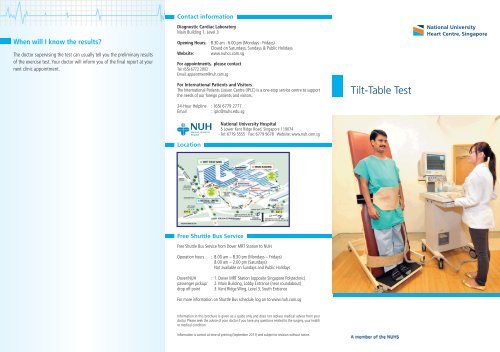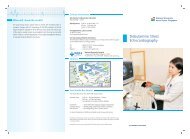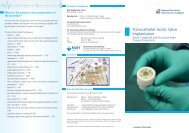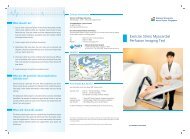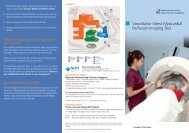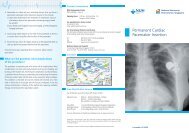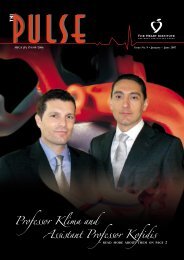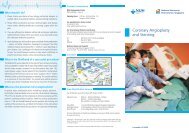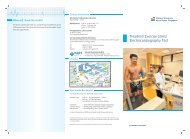Tilt-Table Test - nuhcs
Tilt-Table Test - nuhcs
Tilt-Table Test - nuhcs
- No tags were found...
You also want an ePaper? Increase the reach of your titles
YUMPU automatically turns print PDFs into web optimized ePapers that Google loves.
Contact informationWhen will I know the results?The doctor supervising the test can usually tell you the preliminary resultsof the exercise test. Your doctor will inform you of the final report at yournext clinic appointment.Diagnostic Cardiac LaboratoryMain Building 1, Level 3Opening Hours: 8.30 am - 6.00 pm (Mondays - Fridays)Closed on Saturdays, Sundays & Public HolidaysWebsite: www.<strong>nuhcs</strong>.com.sgFor appointments, please contactTel: (65) 6772 2002Email: appointment@nuh.com.sgFor International Patients and VisitorsThe International Patients Liaison Centre (IPLC) is a one-stop service centre to supportthe needs of our foreign patients and visitors.<strong>Tilt</strong>-<strong>Table</strong> <strong>Test</strong>24-Hour Helpline : (65) 6779 2777Email: iplc@nuhs.edu.sgLocationNational University Hospital5 Lower Kent Ridge Road, Singapore 119074Tel: 6779 5555 Fax: 6779 5678 Website: www.nuh.com.sgFree Shuttle Bus ServiceFree Shuttle Bus Service from Dover MRT Station to NUHOperation hoursDover/NUHpassenger pickup/drop off point: 8.00 am – 8.30 pm (Mondays – Fridays)8.00 am – 2.00 pm (Saturdays)Not available on Sundays and Public Holidays: 1. Dover MRT Station (opposite Singapore Polytechnic)2. Main Building, Lobby Entrance (near roundabout)3. Kent Ridge Wing, Level 3, South EntranceFor more information on Shuttle Bus schedule, log on to www.nuh.com.sgInformation in this brochure is given as a guide only and does not replace medical advice from yourdoctor. Please seek the advice of your doctor if you have any questions related to the surgery, your healthor medical condition.Information is correct at time of printing (September 2011) and subject to revision without notice.
What is a tilt-table test?Syncope, or fainting spells, is a common clinical problem with many possiblecauses. One of the common causes is neurocardiogenic syncope, also called‘emotional’ or ‘vasovagal’ syncope, which is a form of neurally mediatedreflex response. The attack is characterized by a patient developing warningsymptoms such as yawning, nausea, blurred vision before finally losingconsciousness. Low blood pressure and slow heart rate commonly accompanythe fainting spell.<strong>Tilt</strong>-table test is a test that is used to provoke such an attack and reproducepatients’ symptoms in a controlled manner. It is performed to confirm thediagnosis in patients with repeated syncope. It is a simple, non-invasivetechnique with high diagnostic accuracy, and can also be used to evaluatethe response of an individual to drug treatment for this condition.Computer screen displaying heart rate and rhythm during the testWhat can I expect?The test is quite comfortable and no fasting before the procedure is required.However, you should only take a light meal preferably 2 hours before theprocedure. No pre-medication is given. Throughout the test, you will belying flat on your back and strapped onto a table, which can be tilted atany angle. The table will be tilted at 75 degrees with your head up. A cuffis wrapped round your arm to monitor your blood pressure regularly.Electrodes will also be attached to your chest to check on your heart rateand rhythm. A doctor will be by your side to ensure that the procedure issafely carried out.You will remain strapped onto the table throughout the procedure. This isto prevent you from falling and sustaining any injuries should you faintduring the test. Also, it allows the technologist to lie you flat quickly forrecovery purposes. If you do not develop any fainting spells after standingfor 30 minutes, the doctor will give a puff of Glyceryl Trinitrate (GTN) 400mcgunder the tongue. The medicine usually does not cause any serious sideeffect although you may feel an increase in your heart rate. The technologistwill continue to monitor you for the next 15 minutes, during whichyour symptoms may or may not be reproduced. The test will be stoppedafter that.Should you feel faint during the test, please let your supervising doctorknow so that he can attend to you. Do not be alarmed should you loseconsciousness in a positive test as you will recover very shortly upon lyingin a supine position. You will be monitored till you feel completely well.When the procedure is completed, a cardiologist will review the test resultsand prepare a report of the examination to be sent to your referring doctor.What should I do?1. You should only take a light meal before the test, preferably 2 hoursbefore the appointment.2. You should come in light clothing to facilitate the examination.3. Keep your arm straight and relaxed for accurate recording of yourblood pressure.


